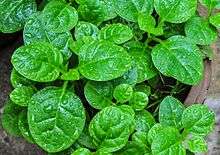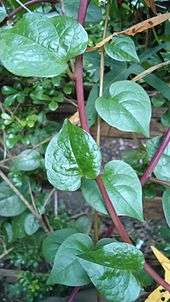Basella alba
| Malabar spinach | |
|---|---|
| Scientific classification | |
| Kingdom: | Plantae |
| Clade: | Angiosperms |
| Clade: | Eudicots |
| Order: | Caryophyllales |
| Family: | Basellaceae |
| Genus: | Basella |
| Species: | B. alba |
| Binomial name | |
| Basella alba | |
| Synonyms[1] | |
| |


| Nutritional value per 100 g (3.5 oz) | |
|---|---|
| Energy | 79 kJ (19 kcal) |
|
3.4 g | |
|
0.3 g | |
|
1.8 g | |
| Vitamins | Quantity %DV† |
| Vitamin A equiv. |
50% 400 μg |
| Thiamine (B1) |
4% 0.05 mg |
| Riboflavin (B2) |
13% 0.155 mg |
| Niacin (B3) |
3% 0.5 mg |
| Vitamin B6 |
18% 0.24 mg |
| Folate (B9) |
35% 140 μg |
| Vitamin C |
123% 102 mg |
| Minerals | Quantity %DV† |
| Calcium |
11% 109 mg |
| Iron |
9% 1.2 mg |
| Magnesium |
18% 65 mg |
| Manganese |
35% 0.735 mg |
| Phosphorus |
7% 52 mg |
| Potassium |
11% 510 mg |
| Zinc |
5% 0.43 mg |
|
| |
| |
|
†Percentages are roughly approximated using US recommendations for adults. Source: USDA Nutrient Database | |
Basella alba is an edible perennial vine in the family Basellaceae. It is found in tropical Asia and Africa where it is widely used as a leaf vegetable. It is native to the Indian Subcontinent, Southeast Asia and New Guinea. It is reportedly naturalized in China, tropical Africa, Brazil, Belize, Colombia, the West Indies, Fiji and French Polynesia.[1]
Basella alba is known under various common names, including Malabar Spinach, vine spinach, red vine spinach, climbing spinach, creeping spinach, buffalo spinach and Ceylon spinach among others.[2][3][4]
Description
Basella alba is a fast-growing, soft-stemmed vine, reaching 10 metres (33 ft) in length. Its thick, semi-succulent, heart-shaped leaves have a mild flavour and mucilaginous texture. It is rich in vitamins A and C, iron and calcium. It has been shown to contain certain phenolic phytochemicals and it has antioxidant properties.
It is also called Malabar Spinach. There are two varieties - green and red. The stem of the Basella alba is green and the stem of the cultivar Basella alba 'Rubra' is reddish-purple; the leaves in both cases are green. The stem when crushed usually emits a strong scent. Malabar Spinach can be found at many Asian supermarkets, as well as farmers' markets.
Soil and climate requirements
Basella alba grows well under full sunlight in hot, humid climates and in areas lower than 500 metres (1,600 ft) above sea level. The plant is native to tropical Asia.[5] Growth is slow in low temperatures resulting in low yields. Flowering is induced during the short-day months of November to February. It grows best in sandy loam soils rich in organic matter with pH ranging from 5.5 to 8.0.
Uses
Typical of leaf vegetables, Malabar spinach is high in vitamin A, vitamin C, iron, and calcium. It is low in calories by volume, but high in protein per calorie. The succulent mucilage is a particularly rich source of soluble fiber. Among many other possibilities, Malabar spinach may be used to thicken soups or stir-fries with garlic and chili peppers.
In the Philippines, the leaves of this vegetable is one of the main ingredients in an all vegetable dish called utan that is served over rice. It is usually cooked with sardines, onions, garlic, and parsley.
In Karnataka Cuisine (Karavali and Malnad regions), the leaves and stems are used to make Basale Soppu Saaru/Curry (Especially in combination with Jackfruit seed) and soupy raita with curd. Beary Muslims of coastal Karnataka prepare Basalede kunhi Pindi (small rice dumplings smeared in gravy prepared from Malabar spinach and dried tuna ). In Bengali cuisine it is widely used both in a vegetable dish, cooked with red pumpkin, and in non-vegetarian dishes, cooked with the bones of the Ilish fish and may also be cooked with shrimps. In Andhra Pradesh, a southern state in India, a curry of Basella and Yam is made popularly known as Kanda Bachali Koora [Yam and Basella curry]. Also it used to make the snack item bachali koora bajji. In Odisha, India, it is used to make Curries and Saaga (any type of dish made from green leafy vegetables is called Saaga in Odisha). In the Western Ghats in Maharashtra, India, it is used to make bhaji (भजी). It is also known as daento or valchi bhaji in Konkani. A popular Mangalorean dish is "Valchi Bhaji and Shrimp - Curry".
The vegetable is used in Chinese cuisine. It has many names including flowing water vegetable. It is often used in stir-frys and soups. In Vietnam, particularly the north, it is cooked with crab meat, luffa and jute to make soup.
In Africa, the mucilaginous cooked shoots are most commonly used.[6]
Names
Basella alba is usually referred to as the "spinach" equivalent of a certain country in English, even though it is not related to the true spinach (Spinacia oleracea). Examples include "Malabar spinach", "Ceylon spinach", "Indian spinach", "Surinam spinach", "Chinese spinach", or "Vietnamese spinach". Other common names include "vine spinach", "red vine spinach", "climbing spinach", "creeping spinach", "buffalo spinach", "Malabar nightshade", and "broad bologi".
In South Asia, it is known as pui shak (পুঁই শাক) in Bengali; poi ni bhaji in Gujarati; basale soppu(ಬಸಳೆ ಸೊಪ್ಪು) in Kannada; valchi bhaji or daento or vauchi bhaji in Konkani; vallicheera (വള്ളിച്ചീര ) in Malayalam; mayalu (मायाळू) in Marathi; poi saaga (ପୋଈ ଶାଗ) in Odia; vel niviti (sudu) in Sinhalese; kodip pasaLi (கொடிப்பசலை) in Tamil; bachhali (బచ్చలి) in Telugu; and basale in Tulu.
In Southeast Asia, it is known as kubay in Ibanag; libatu in Kapampangan; and alugbati in Tagalog and the Visayan languages of the Philippines. It is known as pak plang (ผักปลัง) in Thai; and mồng tơi in Vietnamese.[5]
In East Asia, it is known as 潺菜, 木耳菜, 落葵 or 蚕菜, being saan choy, xan choy, shan tsoi, luo kai, shu chieh, and lo kwai in some of readings of Cantonese; and tsurumurasaki (つるむらさき) in Japanese.[5]
In Latin America, it is known as espinaca china ([espiˈnaka ˈtʃina], "Chinese spinach") or espinaca de Malabar ([espiˈnaka ðe malaˈβaɾ], "Malabar spinach") in Spanish, and bertalha ([beʁˈtaʎɐ], etymology is tentatively "creepy green", "dense green") or espinafre indiano ([ispiˈnafɾ ĩdʒiˈɐ̃nu], "Indian spinach") in Portuguese.
In West Africa, specifically among the Yoruba tribe in South West Nigeria, it is known as "Efo amunututu" translated in Yoruba as the vegetable which “calms your stomach”.
References
- 1 2 Kew World Checklist of Selected Plant Families, Basella alba
- ↑ "Red Stem Malabar Spinach Seeds". Park Seed.
- ↑ "Dictionary of Philippine Vegetables". Retrieved August 31, 2012.
- ↑ "Uses and Health Benefits of Alugbati / Malabar Spinach". foodrecap.net.
- 1 2 3 "WorldCrops Malabar Spinach". Retrieved August 31, 2012.
- ↑ Grubben, G.J.H. & Denton, O.A. (2004) Plant Resources of Tropical Africa 2. Vegetables. PROTA Foundation, Wageningen; Backhuys, Leiden; CTA, Wageningen.
External links
- " Multilingual taxonomic information". University of Melbourne.

- PROTAbase on Basella alba
- Photo and multilingual synonyms
- University of Florida Agricultural Extension
- Evaluation of tropical leaf vegetables in the Virgin Islands
- Malabar Spinach Basella alba, B. ruba (WorldCrops)
- Dressler, S.; Schmidt, M. & Zizka, G. (2014). "Basella alba". African plants – a Photo Guide. Frankfurt/Main: Forschungsinstitut Senckenberg.